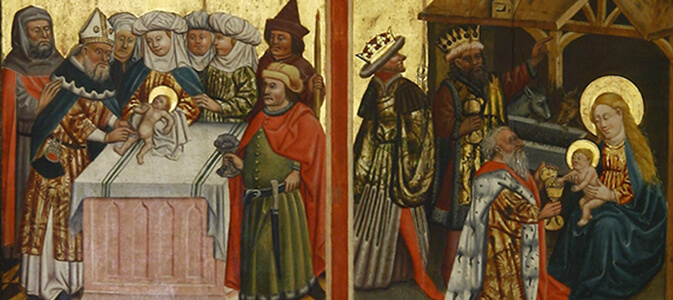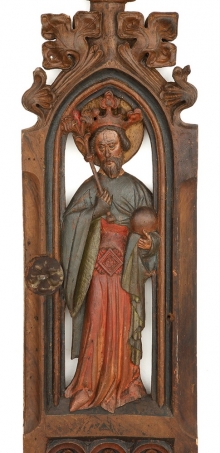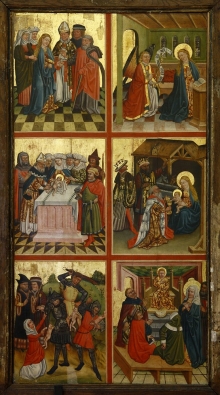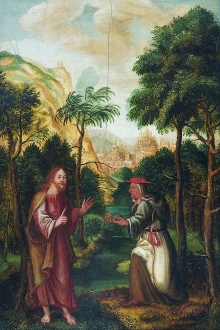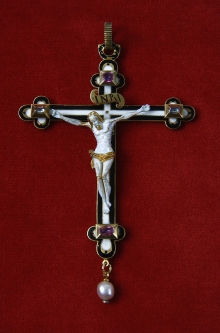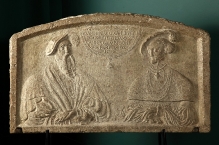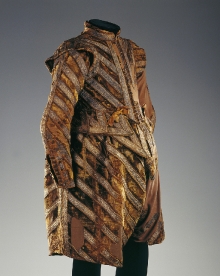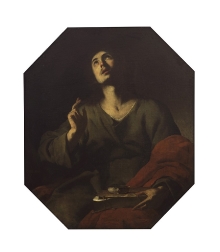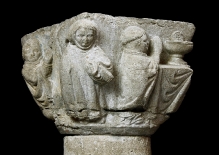The collection of the Old Art Department consists of collection of medieval art, painting and sculpture from the 16th to the 18th century, graphics and drawing, applied arts, militaria and so called antique collection which includes unique bronze reconstructions of world's most famous antique sculptures and antique ceramics.
The history of this collection started at the beginning of the 19th century, when, on the wave of growing interest in the history of the region, the Society of History and Antiquities of Pomerania (Gesellschaft für Pommersche Geschichte und Altertumskunde, 1824) And the Pomeranian Society of Fine Arts (Kunstverein für Pommern, 1834) were established. The collection of the first of the societies, embracing various mementos related to the region's history, including works of art and artistic craftworks in 1928 found their seat in former Landed Gentry House creating Provincial Museum of Pomeranian Antiquities (Provinzialmuseum Pommerscher Altertümer), transformed in 1934 into Pomeranian State Museum (Pommersches Landesmuseum). The collection of the second society gave the beginning to the collection of the City Museum (Stadtmuseum), for which in 1907–1913 a new, magnificent building in the central part of today's Wały Chrobrego was built. On account of donations of Szczecin's patricians (including, above all, Heinrich Dohrn) and activity of the first director Walter Riezler superb collections of antique art and modern painting were gathered in the City Museum.
During the second world war the collections of Szczecin museums were considerably dispersed. The part of the painting collection of the City Museum was evacuated into the heart of Germany creating, after the war, Stiftung Pommern gallery in Kiel, and then Pommersches Landesmuseum in Greifswald. The collection that remained in Szczecin bacame the basis for newly created Polish museum. Some of the works lost during the war or taken from Szczecin after it, as late, as after many years returned to Szczecin museum (e.g. precious drawing collection of the Tiepolos family was recovered in 1956, antique collection in 1994, sections of the Ueckermünde altar – in 2006).
The collections of the Old Art Department were also systematically filled in mainly by purchases, with new, sometimes very precious objects (e.g., bought in 1978, The Glorification of Duke Philip II by Pancratius Reinicke of 1608 or, purchased in 2008 renaissance cross-shaped duchess Erdmut's jewel), and some of the collections, like the one of over 250 silver objects, were created almost from scratch. The most precious post-war acquisition is a world-class collection of jewels and robes of Western-Pomeranian dukes brought out in 1946 of Griffins’ crypt in Szczecin.
The collections are presented in permanent exhibitions of the Old Art Department: The Golden Age of Pomerania. Art at the Court of the Pomeranian Dukes in the 16th and 17th Centuries, Old Silver, Ceramics and Glass from 16th to 20th Century (27 Staromłyńska St.) and Ancient Roots of Europe. Dohrns’ Szczecin Collection (3 Wały Chrobrego St.), they are also a large part of exhibitions of other departments, most of all Szczecin’s History Museum (8 Księcia Mściwoja II St.).
- Stalla rajców z Kołobrzegu, ścianka skrajna z przedstawieniem św. Olafa, warsztat kołobrzeski, kon. XIV w., drewno dębowe, polichromia, 286 x 45 cm, fot. G. Solecki
- Author: No Data
- Poliptyk Stargardzki, awers lewego skrzydła zewnętrznego, warsztat Poliptyku Stargardzkiego, ok. 1450, deska dębowa, tempera, 230 x 129 cm, fot. G. Solecki
- Author: No Data
- Święta Dorota, z ołtarza z kościoła św. Gertrudy ze Szczecina, warsztat Mistrza Tryptyku ś.ś. Piotra i Pawła w Szczecinie, ok. 1520–1530, drewno lipowe, polichromia, wys. 116 cm, fot. G. Solecki
- Author: No Data
- Lucas Cranach Młodszy (1515–1586), Portret księcia pomorskiego Filipa I, 1541, olej, deska, 60 x 46 cm, fot. G. Solecki
- Author: No Data
- Artysta nieznany, Kuszenie Chrystusa, ok. 1577, olej, deska, 57 x 38 cm, fot. G. Solecki, A. Piętak
- Author: No Data
- Krzyżyk księżnej Erdmuty, po 1600, złoto, emalia, diamenty, rubiny, perła, 9 x 5,6 cm, fot. G. Solecki
- Author: No Data
- Płyta z portretami księcia Barnima IX i jego żony Anny brunszwicko-lüneburskiej z Kołbacza, artysta z kręgu Hansa Schencka zw. Scheusslich, 1545, wapień gotlandzki, 87 x 145 cm, fot. G. Solecki
- Author: No Data
- Strój księcia Ulryka, 1622, aksamit, naszycia ze złotego galonu, wams – długość przodu 36 cm, spodnie – dł. 60 cm, fot. G. Solecki
- Author: No Data
- Bernardo Cavallino, Święty Jan Ewangelista, 1635–1640, olej, płótno, 102 x 87 cm, fot. G. Solecki
- Author: No Data
- Czarci kapitel z Kołbacza, fragment z przedstawieniem mszy świętej, warsztat gotlandzki, 1330–1340, wapień gotlandzki, 37 x 56 x 53 cm, fot. G. Solecki
- Author: No Data
